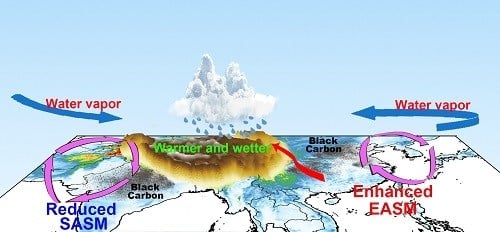Role and Mechanisms of Black Carbon Affecting Water Vapor Transport to Tibet
Abstract
1. Introduction
2. Data and Methods
2.1. The Uncertainties and Applicability of Each Data
2.1.1. Multi-Angle Imaging Spectro Radiometer (MISR)
2.1.2. Cloud and Earth’s Radiant Energy System (CERES)
2.1.3. ERA-Interim
2.1.4. Global Precipitation Climatology Project (GPCP)
2.1.5. Modern-Era Retrospective Analysis for Research and Applications (MERRA)
2.1.6. National Centers for Environment Prediction (NCEP)
2.1.7. Emission Data of Aerosols and Greenhouse Gases
2.2. Methods of Calculating Asian Summer Monsoon and Water Vapor Transport Changes
2.2.1. Estimation of Summer Monsoon
2.2.2. Changes of Water Vapor
2.3. Description of Model Setting
2.4. The Study Area
3. Results
3.1. Model Assessment
3.2. The Radiative Forcing
3.3. Changes in Surface Temperature
3.4. Changes in Atmospheric Circulation
3.5. Effects of BC on the Water Vapor Budget
4. Discussion
5. Conclusions
Author Contributions
Funding
Acknowledgments
Conflicts of Interest
References
- Roberts, D.L.; Jones, A. Climate sensitivity to black carbon aerosol from fossil fuel combustion. J. Geophys. Res. Atmos. 2004, 109, D16202. [Google Scholar] [CrossRef]
- Wu, J.; Fu, C.; Xu, Y.; Tang, J.P.; Wang, W.; Wang, Z. Simulation of direct effects of black carbon aerosol on temperature and hydrological cycle in Asia by a Regional Climate Model. Meteorol. Atmos. Phys. 2008, 100, 179–193. [Google Scholar] [CrossRef]
- Booth, B.; Bellouin, N. Black carbon and atmospheric feedbacks. Nature 2015, 519, 167–168. [Google Scholar] [CrossRef]
- Ji, D.; Li, L.; Pang, B.; Xue, P.; Wang, Y.; Wang, L.; Wu, Y.; Zhang, H. Characterization of black carbon in an urban-rural fringe area of Beijing. Environ. Pollut. 2017, 223, 524–534. [Google Scholar] [CrossRef] [PubMed]
- Stjern, C.W.; Samset, B.H.; Myhre, G.; Forster, P.M.; Hodnebrog, Ø.; Andrews, T.; Boucher, O.; Faluvegi, G.; Iversen, T.; Kasoar, M.; et al. Rapid Adjustments Cause Weak Surface Temperature Response to Increased Black Carbon Concentrations. J. Geophys. Res. Atmos. 2017, 122, 462–481. [Google Scholar] [CrossRef]
- Ramanathan, V.; Chung, C.; Kim, D.; Bettge, T.; Buja, L.; Kiehl, J.; Washington, W.; Fu, Q.; Sikka, D.; Wild, M. Atmospheric brown clouds: Impacts on South Asian climate and hydrological cycle. Proc. Natl. Acad. Sci. USA 2005, 102, 5326–5333. [Google Scholar] [CrossRef]
- Liu, Y.; Jia, R.; Dai, T.; Xie, Y.; Shi, G. A review of aerosol optical properties and radiative effects. J. Meteor. Res. 2014, 28, 1003–1028. [Google Scholar] [CrossRef]
- Chen, B.; Chen, J.; Bai, Z.; Cui, X.; Andersson, A.; Gustafsson, Ö. Light absorption enhancement of black carbon from urban haze in Northern China winter. Environ. Pollut. 2017, 221, 418–426. [Google Scholar] [CrossRef]
- Liu, Y.; Sato, Y.; Jia, R.; Xie, Y.; Huang, J.; Nakajima, T. Modeling study on the transport of summer dust and anthropogenic aerosols over the Tibetan Plateau. Atmos. Chem. Phys. 2015, 15, 12581–12594. [Google Scholar] [CrossRef]
- Liu, Y.; Zhu, Q.; Wang, R.; Xiao, K.; Cha, P. Distribution, source and transport of the aerosols over Central Asia. Atmos. Environ. 2019, 210, 120–131. [Google Scholar] [CrossRef]
- Jia, R.; Luo, M.; Liu, Y.; Zhu, Q.; Hua, S.; Wu, C.; Shao, T. Anthropogenic Aerosol Pollution over the Eastern Slope of the Tibetan Plateau. Adv. Atmos. Sci. 2019, 36, 847–862. [Google Scholar] [CrossRef]
- Ming, J.; Xiao, D.; Du, C.; Yang, G. An overview of black carbon deposition in High Asia glaciers and its impacts on radiation balance. Adv. Water Res. 2013, 55, 80–87. [Google Scholar] [CrossRef]
- Liu, Y.; Huang, J.; Shi, G.; Takamura, T.; Khatri, P.; Bi, J.; Shi, J.; Wang, T.; Wang, X.; Zhang, B. Aerosol optical properties determined from sky-radiometer over Loess Plateau of Northwest China. Atmos. Chem. Phys. 2011, 11, 23883–23910. [Google Scholar] [CrossRef]
- Jia, R.; Liu, Y.; Hua, S.; Zhu, Q.; Shao, T. Estimation of the aerosol radiative effect over the Tibetan Plateau based on the latest CALIPSO product. J. Meteorol. Res. 2018, 32, 707–722. [Google Scholar] [CrossRef]
- He, C.; Li, Q.; Liou, K.; Takano, Y.; Gu, Y.; Qi, L.; Mao, Y.; Leung, L. Black carbon radiative forcing over the Tibetan Plateau. Geophys. Res. Lett. 2014, 41, 7806–7813. [Google Scholar] [CrossRef]
- Flanner, M.; Zender, C.; Randerson, J.; Rasch, P. Present-day climate forcing and response from black carbon in snow. J. Geophys. Res. Atmos. 2007, 112, D11202. [Google Scholar] [CrossRef]
- Xu, B.; Cao, J.; Hansen, J.; Yao, T.; Joswia, D.; Wang, N.; Wu, G.; Wang, M.; Zhao, H.; Yang, W.; et al. Black soot and the survival of Tibetan glaciers. Proc. Natl. Acad. Sci. USA 2009, 106, 22114–22118. [Google Scholar] [CrossRef]
- Jacobi, H.; Lim, S.; Ménégoz, M.; Ginot, P.; Laj, P.; Bonasoni, P.; Stocchi, P.; Marinoni, A.; Arnaud, Y. Black carbon in snow in the upper Himalayan Khumbu Valley, Nepal: Observations and modeling of the impact on snow albedo, melting, and radiative forcing. Cryosphere 2015, 9, 1685–1699. [Google Scholar] [CrossRef]
- He, C.; Flanner, M.; Chen, F.; Barlage, M.; Liou, K.; Kang, S.; Ming, J.; Qian, Y. Black carbon-induced snow albedo reduction over the Tibetan Plateau: Uncertainties from snow grain shape and aerosol–snow mixing state based on an updated SNICAR model. Atmos. Chem. Phys. 2018, 18, 11507–11527. [Google Scholar] [CrossRef]
- Hua, S.; Liu, Y.; Jia, R.; Chang, S.; Wu, C.; Zhu, Q.; Shao, T.; Wang, B. Role of Clouds in Accelerating Cold-Season Warming During 2000-2015 over the Tibetan Plateau. Int. J. Climatol. 2018, 38, 4950–4966. [Google Scholar] [CrossRef]
- Liu, Y.; Hua, S.; Jia, R.; Huang, J. Effect of aerosols on the ice cloud properties over the Tibetan Plateau. J. Geophys. Res. Atmos. 2019, 124, 9594–9608. [Google Scholar] [CrossRef]
- Liu, Y.; Zhu, Q.; Huang, J.; Hua, S.; Jia, R. Impact of dust-polluted convective clouds over the Tibetan Plateau on downstream precipitation. Atmos. Environ. 2019, 209, 67–77. [Google Scholar] [CrossRef]
- Liu, Y.; Li, Y.; Huang, J.; Wang, S.; Zhu, Q. Attribution of Tibetan Plateau to the northern drought. Natl. Sci. Rev. 2019, nwz191. [Google Scholar] [CrossRef]
- Liu, Y.; Luo, R.; Zhu, Q.; Hua, S.; Wang, B. Cloud Ability to Produce Precipitation over Arid and Semiarid Regions of Central and East Asia. Int. J. Climatol. 2019, 1–14. [Google Scholar] [CrossRef]
- Liu, Y.; Wu, C.; Jia, R.; Huang, J. An overview of the influence of atmospheric circulation on the climate in arid and semi-arid region of Central and East Asia. Sci. China Earth Sci. 2018, 61, 31–42. [Google Scholar] [CrossRef]
- Qian, Y.; Flanner, M.; Leung, L.; Wang, W. Sensitivity studies on the impacts of Tibetan Plateau snowpack pollution on the Asian hydrological cycle and monsoon climate. Atmos. Chem. Phys. 2011, 11, 1929–1948. [Google Scholar] [CrossRef]
- Lau, K.; Kim, M.; Kim, K. Asian summer monsoon anomalies induced by aerosol direct forcing: The role of the Tibetan Plateau. Clim. Dyn. 2006, 26, 855–864. [Google Scholar] [CrossRef]
- Lau, W.; Kim, K. Fingerprinting the impacts of aerosols on long-term trends of the Indian summer monsoon regional rainfal. Geophys. Res. Lett. 2010, 37, 127–137. [Google Scholar] [CrossRef]
- D’Errico, M.; Cagnazzo, C.; Fogli, P.; Lau, W.; von Hardenberg, J.; Fierli, F.; Cherchi, A. Indian monsoon and the elevated-heat-pump mechanism in a coupled aerosol-climate model. J. Geophys. Res. Atmos. 2015, 120, 8712–8723. [Google Scholar] [CrossRef]
- Chung, C.; Ramanathan, V. Weakening of North Indian SST gradients and the monsoon rainfall in India and the Sahel. J. Clim. 2006, 19, 2036–2045. [Google Scholar] [CrossRef]
- Meehl, G.A.; Arblaster, J.M.; Collins, W.D. Effects of black carbon aerosols on the Indian monsoon. J. Clim. 2008, 21, 2869–2882. [Google Scholar] [CrossRef]
- Wu, G.; Li, Z.; Fu, C.; Zhang, X.; Zhang, R.; Zhang, R.; Zhou, T.; Li, J.; Zhou, D.; Wu, L.; et al. Advances in studying interactions between aerosols and monsoon in China. Sci. Chin. Earth Sci. 2016, 59, 1–16. [Google Scholar] [CrossRef]
- Li, H.; Dai, A.; Zhou, T.; Lu, J. Responses of EASM to historical SST and atmospheric forcing during 1950–2000. Clim. Dyn. 2010, 34, 501–514. [Google Scholar] [CrossRef]
- Zhuang, B.; Chen, H.; Li, S.; Wang, T.; Liu, J.; Zhang, L.; Liu, H.; Xie, M.; Chen, P.; Li, M.; et al. The direct effects of black carbon aerosols from different source sectors in East Asia in summer. Clim. Dyn. 2019, 53, 5293–5310. [Google Scholar] [CrossRef]
- Renhe, Z. Relations of Water Vapor Transport from Indian Monsoon with That over East Asia and the Summer Rainfall in China. Adv. Atmos. Sci. 2001, 18, 1005–1017. [Google Scholar] [CrossRef]
- Zhou, T.; Yu, R. Atmospheric water vapor transport associated with typical anomalous summer rainfall patterns in China. J. Geophys. Res. Atmos. 2005, 110, D8. [Google Scholar] [CrossRef]
- Ma, Y.; Lu, M.; Chen, H.; Pan, M.; Hong, Y. Atmospheric moisture transport versus precipitation across the Tibetan Plateau: A mini-review and current challenges. Atmos. Res. 2018, 209, 50–58. [Google Scholar] [CrossRef]
- Dong, W.; Lin, Y.; Wright, J.; Xie, Y.; Xu, F.; Xu, W.; Wang, Y. Indian Monsoon Low-Pressure Systems Feed Up-and-Over Moisture Transport to the Southwestern Tibetan Plateau. J. Geophys. Res. Atmos. 2017, 122, 12–140. [Google Scholar] [CrossRef]
- Li, C.; Zuo, Q.; Xu, X.; Gao, S. Water vapor transport around the Tibetan Plateau and its effect on summer rainfall over the Yangtze River valley. J. Meteorol. Res. 2016, 30, 472–482. [Google Scholar] [CrossRef]
- Wu, H.; Li, X.; Zhang, J.; Li, J.; Liu, J.; Tian, L.; Fu, C. Stable isotopes of atmospheric water vapour and precipitation in the northeast Qinghai-Tibetan Plateau. Hydrol. Process. 2019, 33, 2997–3009. [Google Scholar] [CrossRef]
- Zhao, Y.; Zhou, T. Asian water tower evinced in total column water vapor: A comparison among multiple satellite and reanalysis data sets. Clim. Dyn. 2019, 1–15. [Google Scholar] [CrossRef]
- Zhou, C.; Zhao, P.; Chen, J. The Interdecadal Change of Summer Water Vapor over the Tibetan Plateau and Associated Mechanisms. J. Clim. 2019, 32, 4103–4119. [Google Scholar] [CrossRef]
- Huang, J.; Yu, H.; Guan, X.; Wang, G.; Guo, R. Accelerated dryland expansion under climate change. Nat. Clim. Change 2016, 6, 166–171. [Google Scholar] [CrossRef]
- Huang, J.; Li, Y.; Fu, C.; Chen, F.; Fu, Q.; Dai, A.; Shinoda, M.; Ma, Z.; Guo, W.; Li, Z.; et al. Dryland climate change Recent progress and challenges. Rev.Geophys. 2017, 55, 719–778. [Google Scholar] [CrossRef]
- Martonchik, J.V.; Diner, D.J.; Crean, K.A.; BullRegional, M.A. Regional aerosol retrieval results from MISR. IEEE Trans. Geosci. Remote Sens. 2002, 40, 1520–1531. [Google Scholar] [CrossRef]
- Diner, D.; Beckert, J.; Reilly, T.; Bruegge, C.; Conel, J.; Kahn, R.; Martonchik, J.; Ackerman, T.; Davies, R.; Gerstl, S.; et al. Multi-angle Imaging SpectroRadiometer (MISR) instrument description and experiment overview. IEEE Trans. Geosci. Remote Sens. 1998, 36, 1072–1087. [Google Scholar] [CrossRef]
- Wielicki, B.; Barkstrom, B.; Harrison, E.; Lee, R.; Smith, G.; Cooper, J. Clouds and the Earth’s Radiant Energy System (CERES): An Earth Observing System Experiment. Bull. Am. Meteorol. Soc. 1996, 77, 853–868. [Google Scholar] [CrossRef]
- Almorox, J.; Ovando, G.; Sayago, S.; Bocco, M. Assessment of surface solar irradiance retrieved by CERES. Int. J. Remote Sens. 2017, 38, 3669–3683. [Google Scholar] [CrossRef]
- Kato, S.; Loeb, N.G.; Rutan, D.A.; Rose, F.G.; Sun-Mack, S.; Miller, W.F.; Chen, Y. Uncertainty estimate of surface irradiances computed with MODIS-, CALIPSO-, and CloudSat-derived cloud and aerosol properties. Surv. Geophys. 2012, 33, 395–412. [Google Scholar] [CrossRef]
- Dee, D.P.; Uppala, S.M.; Simmons, A.J.; Berrisford, P.; Poli, P.; Kobayashi, S.; Andrae, U.; Balmaseda, M.A.; Balsamo, G.; Bauer, D.P.; et al. The ERA-Interim reanalysis: Configuration and performance of the data assimilation system. Q. J. R. Meteorol. Soc. 2011, 137, 553–597. [Google Scholar] [CrossRef]
- Wang, S.; Zhang, M.; Sun, M.; Wang, B.; Huang, X.; Wang, Q.; Feng, F. Comparison of surface air temperature derived from NCEP/DOE R2, ERA-Interim, and observations in the arid northwestern China: A consideration of altitude errors. Theor. Appl. Climatol. 2015, 119, 99–111. [Google Scholar] [CrossRef]
- You, Q.L.; Min, J.Z.; Zhang, W.; Pepin, N.; Kang, S.H. Comparison of multiple datasets with gridded precipitation observations over the Tibetan Plateau. Clim. Dyn. 2014, 45, 791–806. [Google Scholar] [CrossRef]
- Gao, Y.; Liu, M. Evaluation of high-resolution satellite precipitation products using rain gauge observations over the Tibetan Plateau. Hydrol. Earth Syst. Sci. 2013, 17, 837–849. [Google Scholar] [CrossRef]
- Adler, R.F.; Huffman, G.J.; Chang, A.; Ferraro, R.; Xie, P.; Janowiak, J.; Rudolf, B.; Schneider, U.; Curtis, S.; Bolvin, D.; et al. The Version-2 Global Precipitation Climatology Project (GPCP) Monthly Precipitation Analysis (1979–Present). J. Hydrol. 2003, 4, 1147–1167. [Google Scholar] [CrossRef]
- Randles, C.; Coauthors. The MERRA-2 aerosol reanalysis, 1980 onward. Part I: System description and data assimilation evaluation. J. Clim. 2017, 30, 6823–6850. [Google Scholar] [CrossRef]
- Gelaro, R.; McCarty, W.; Suarez, M.; Todling, R.; Molod, A.; Takacs, L.; Randles, C.; Darmenov, A.; Bosilovich, M.; Reichle, R.; et al. The Modern-Era Retrospective Analysis for Research and Applications, Version 2 (MERRA-2). J. Clim. 2017, 30, 5419–5454. [Google Scholar] [CrossRef]
- Bao, Q.; Liu, Y.; Shi, J.C.; Wu, G.X. Comparisons of Soil Moisture Datasets over the Tibetan Plateau and Application to the Simulation of Asia Summer Monsoon Onset. Adv. Atmos. Sci. 2010, 27, 303–314. [Google Scholar] [CrossRef]
- Kanamitsu, M.; Ebisuzaki, W.; Woollen, J.; Yang, S.; Hnilo, J.; Fiorino, M.; Potter, G. NCEP-DOE AMIP-II reanalysis (R-2). Bull. Am. Meteorol. Soc. 2002, 83, 1631–1643. [Google Scholar] [CrossRef]
- Kalnay, E.; Kanamitsu, M.; Kistler, R.; Collins, W.; Deaven, D.; Gandin, L.; Iredell, M.; Saha, S.; White, G.; Woollen, J.; et al. The NCEP/NCAR 40-Year Reanalysis Project. Bull. Am. Meteor. Soc. 1996, 77, 461–468. [Google Scholar] [CrossRef]
- Lamarque, J.; Bond, T.; Eyring, V.; Granier, C.; Heil, A.; Klimont, Z.; Lee, D.; Liousse, C.; Mieville, A.; Owen, B.; et al. Historical (1850–2000) gridded anthropogenic and biomass burning emissions of reactive gases and aerosols: Methodology and application. Atmos. Chem. Phys. 2010, 10, 7017–7039. [Google Scholar] [CrossRef]
- Smith, S.J.; Pitcher, H.; Wigley, T.M.L. Global and regional anthropogenic sulfur dioxide emissions. Glob. Planet. Change 2001, 29, 99–119. [Google Scholar] [CrossRef]
- Yang, Y.; Russell, L.M.; Lou, S.; Lamjiri, M.A.; Liu, Y.; Singh, B.; Ghan, S.J.; Richland, W.A. Changes in Sea Salt Emissions Enhance ENSO Variability. J. Clim. 2016, 29, 8575–8588. [Google Scholar] [CrossRef]
- Kiehl, J.; Hack, J.; Bonan, G.; Boville, B.; Williamson, D.; Rasch, P. The National Center for Atmospheric Research Community Climate Model: CCM3. J. Clim. 1998, 11, 1131–1149. [Google Scholar] [CrossRef]
- Li, J.P.; Feng, J.; Li, Y. A possible cause of decreasing summer rainfall in northeast Australia. Int. J. Climatol. 2011, 32, 995–1005. [Google Scholar] [CrossRef]
- Liu, X.; Easter, R.; Ghan, S.; Zaveri, R.; Rasch, P.; Shi, X.; Lamarque, J.; Gettelman, A.; Morrison, H.; Vitt, F.; et al. Toward a minimal representation of aerosols in climate models: Description and evaluation in the Community Atmosphere Model CAM5. Geosci. Model Dev. 2012, 5, 709–739. [Google Scholar] [CrossRef]
- Zhang, L.M.; Gong, S.L.; Padro, J.; Barrie, L. A size-segregated particle dry deposition scheme for an atmospheric aerosol module. Atmos. Environ. 2001, 35, 549–560. [Google Scholar] [CrossRef]
- Rasch, P.J.; Barth, M.C.; Kiehl, J.T.; Schwartz, S.E.; Benkovitz, C.M. A description of the global sulfur cycle and its controlling processes in the National Center for Atmospheric Research Community Climate Model, Version 3. J. Geophys. Res. Atmos. 2000, 105, 1367–1385. [Google Scholar] [CrossRef]
- Morrison, H.; Curry, J.A.; Khvorostyanov, V.I. A new double-moment microphysics parameterization for application in cloud and climate models. part I: Description. J. Atmos. Sci. 2005, 62, 1665–1677. [Google Scholar] [CrossRef]
- Morrison, H.; Gettelman, A. A new two-moment bulk stratiform cloud microphysics scheme in the NCAR Community Atmosphere Model (CAM3), Part I: Description and numerical tests. J. Clim. 2008, 21, 3642–3659. [Google Scholar] [CrossRef]
- Bretherton, C.S.; Park, S. A new moist turbulence parameterization in the community atmosphere model. J. Clim. 2009, 22, 3422–3448. [Google Scholar] [CrossRef]
- Park, S.; Bretherton, C. The university of washington shallow convection and moist turbulence schemes and their impact on climate simulations with the community atmosphere model. J. Clim. 2009, 22, 3449–3469. [Google Scholar] [CrossRef]
- Zhang, W.; Zhou, T.; Zhang, L. Wetting and greening Tibetan Plateau in early summer in recent decades. J. Geophys. Res. Atmos. 2017, 122, 11–5808. [Google Scholar] [CrossRef]
- Yang, Y.; Wang, H.; Smith, S.; Ma, P.; Rasch, P. Source attribution of black carbon and its direct radiative forcing in China. Atmos. Chem. Phys. 2017, 17, 4319–4336. [Google Scholar] [CrossRef]
- Gnanadesikan, A.; Scott, A.; Pradal, M.; Seviour, W.; Waugh, D. Regional Responses to Black Carbon Aerosols: The Importance of Air-Sea Interaction. J. Geophys. Res. Atmos. 2017, 122, 12–982. [Google Scholar] [CrossRef]
- Zhuang, B.; Liu, Q.; Wang, T.; Yin, C.; Li, S.; Xie, M.; Jiang, F.; Mao, H. Investigation on semi-direct and indirect climate effects of fossil fuel black carbon aerosol over China. Theor. Appl. Climatol. 2013, 114, 651–672. [Google Scholar] [CrossRef]
- Li, K.; Liao, H.; Mao, Y.; Ridley, D.A. Source sector and region contributions to concentration and direct radiative forcing of black carbon in China. Atmos. Environ. 2016, 124, 351–366. [Google Scholar] [CrossRef]
- He, J.; Qi, L.; Wei, J.; Chi, Y. Reinvestigations on the East Asian Subtropical Monsoon and Tropical Monsoon. Chin. J. Atmos. Sci. 2007, 31, 1257–1265. [Google Scholar]
- Zhang, C.; Tang, Q.; Chen, D. Recent changes in the moisture source of precipitation over the Tibetan Plateau. J. Clim. 2017, 30, 1807–1819. [Google Scholar] [CrossRef]
- Lin, C.; Chen, D.; Yang, K.; Ou, T. Impact of model resolution on simulating the water vapor transport through the central Himalayas: Implication for models’ wet bias over the Tibetan Plateau. Clim. Dyn. 2018, 51, 3195–3207. [Google Scholar] [CrossRef]
- Kuang, X.; Jiao, J. Review on climate change on the Tibetan Plateau during the last half century. J. Geophys. Res. Atmos. 2016, 121, 3979–4007. [Google Scholar] [CrossRef]
- Yang, S.; Xu, B.; Cao, J.; Zender, C.; Wang, M. Climate effect of black carbon aerosol in a Tibetan Plateau glacier. Atmos. Environ. 2015, 111, 71–78. [Google Scholar] [CrossRef]
- Yang, J.; Kang, S.; Ji, Z.; Chen, D. Modeling the Origin of Anthropogenic Black Carbon and Its Climatic Effect Over the Tibetan Plateau and Surrounding Regions. J. Geophys. Res. Atmos. 2018, 123, 671–692. [Google Scholar] [CrossRef]
- Reutter, P.; Su, H.; Trentmann, M.; Simmel, D.; Rose, S.; Gunthe, H.; Wernli, M.; Andreae, M.O.; Pöschl, U. Aerosol-and updraft-limited regimes of cloud droplet formation: Influence of particle number, size and hygroscopicity on the activation of cloud condensation nuclei (CCN). Atmos. Chem. Phys. 2009, 9, 7067–7080. [Google Scholar] [CrossRef]
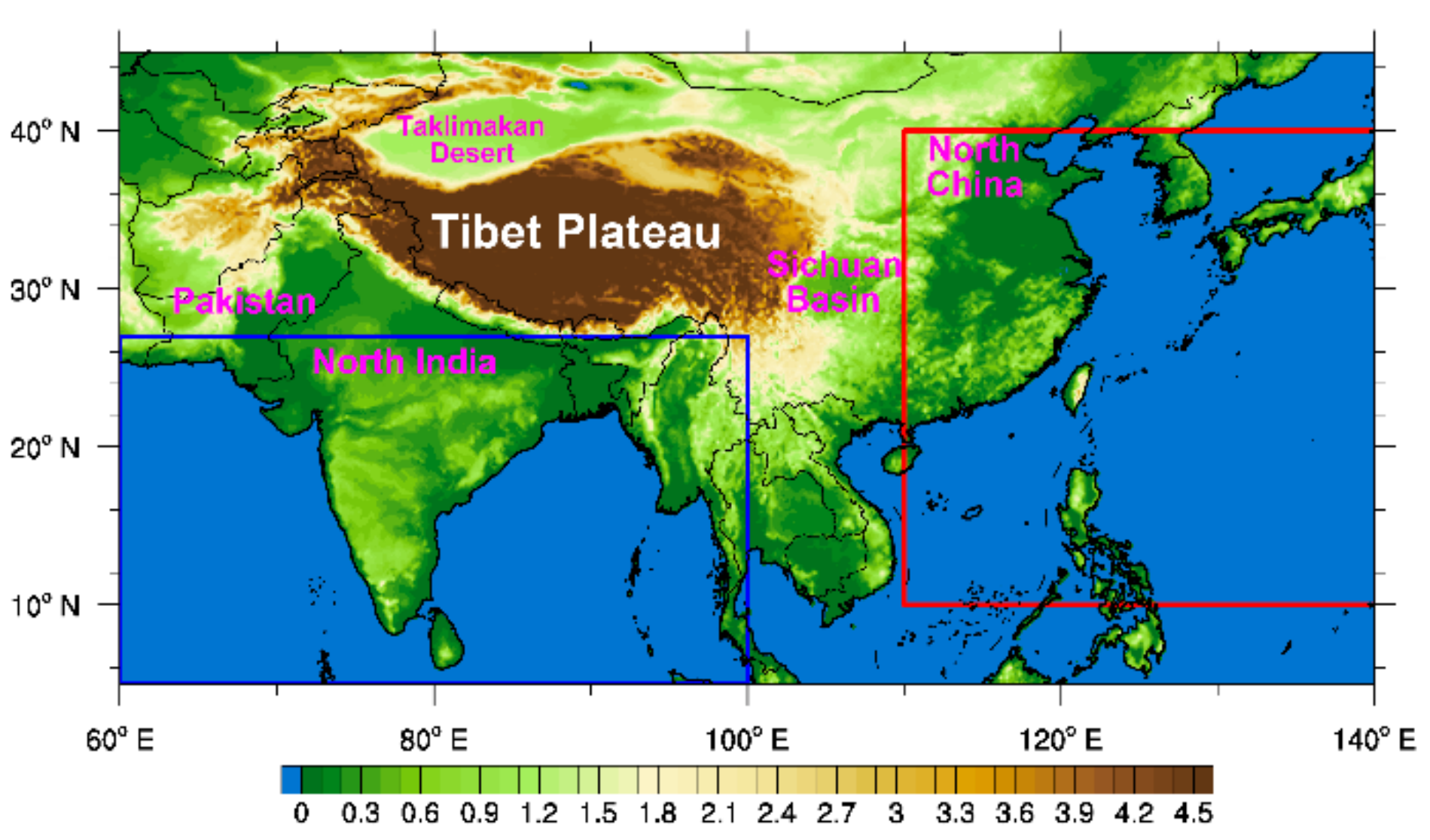
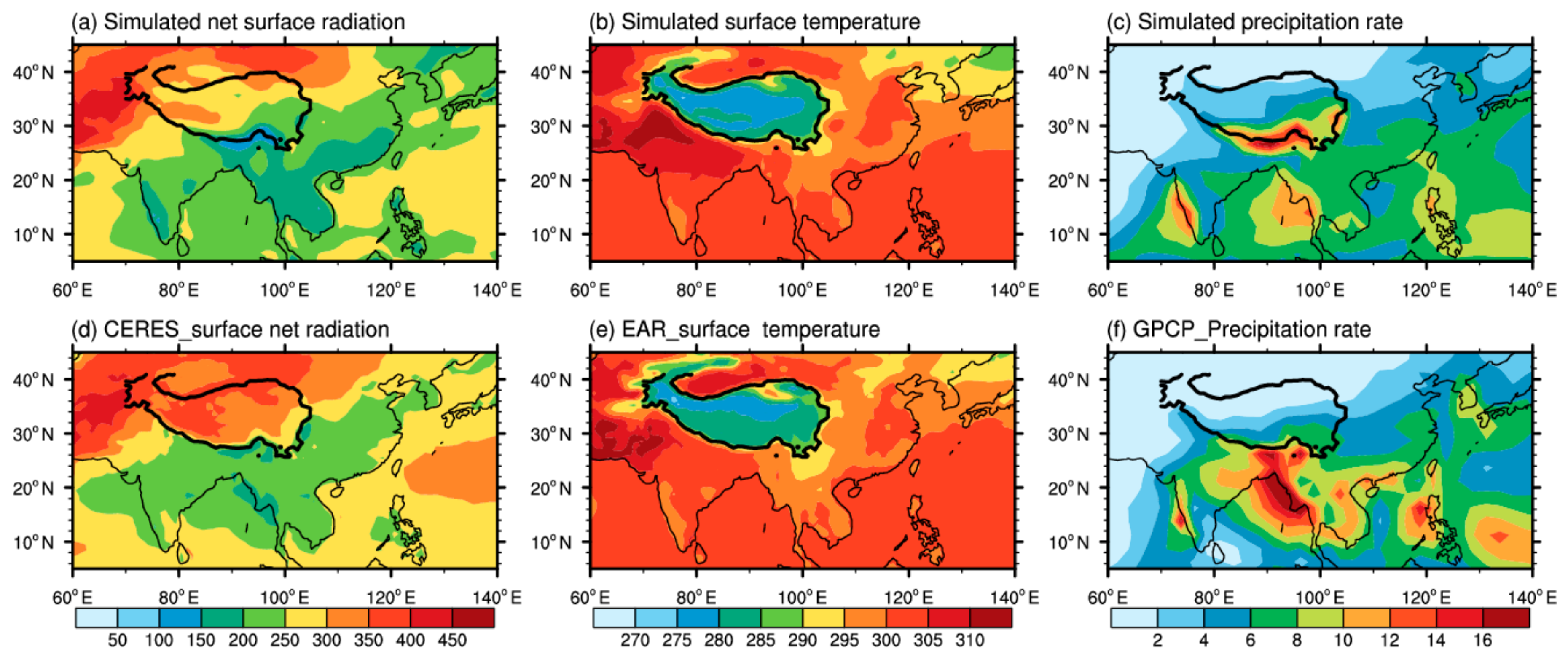
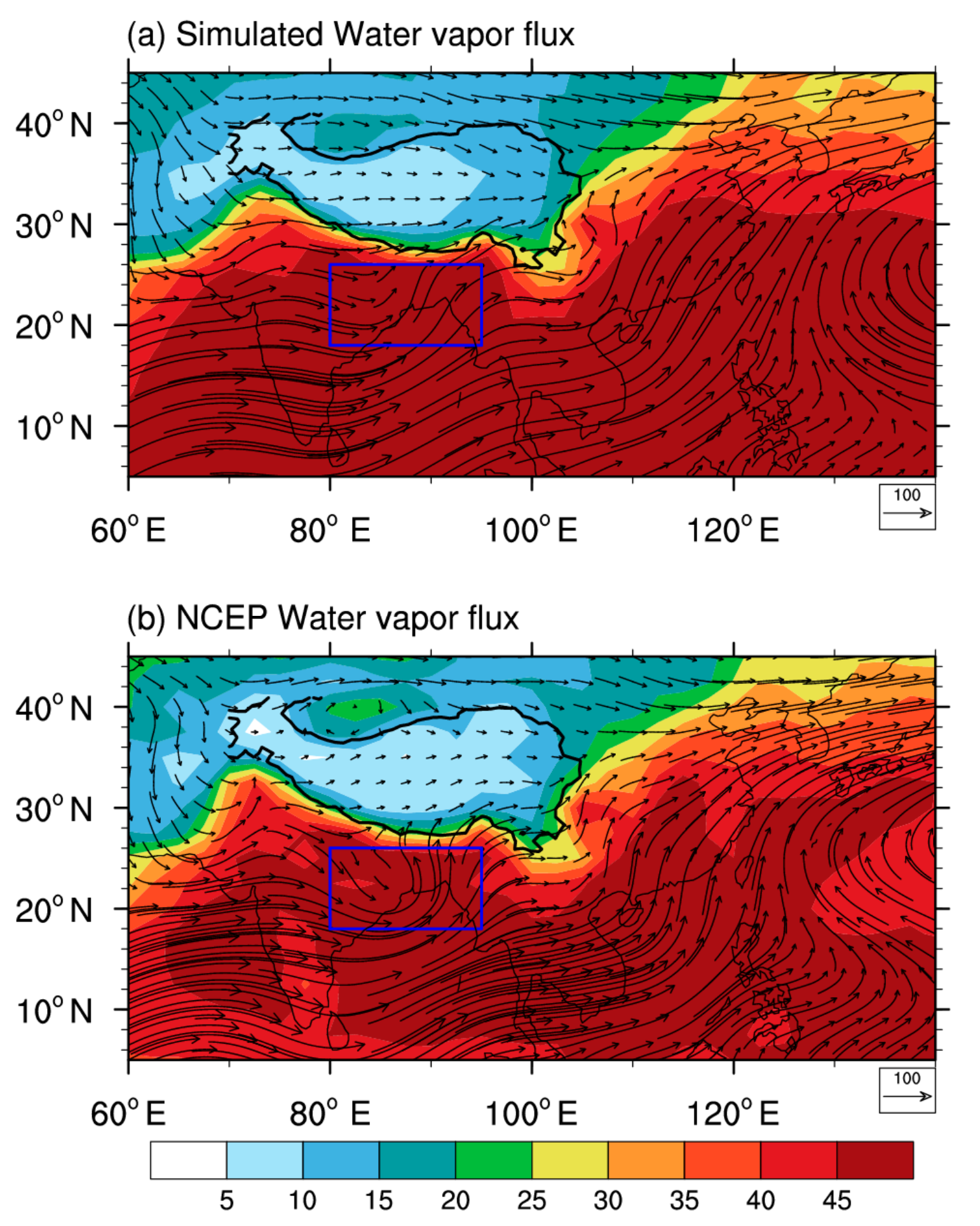
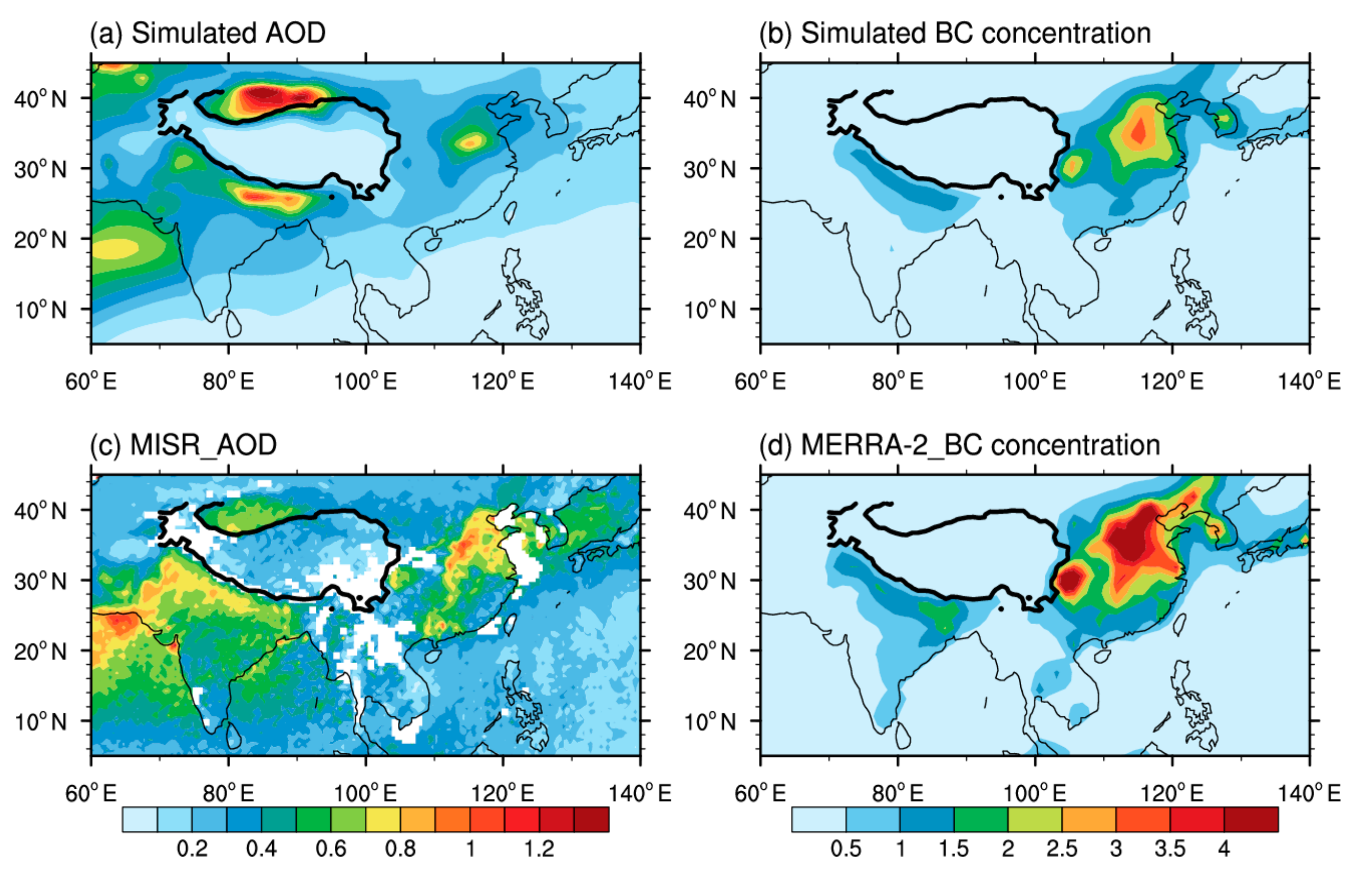
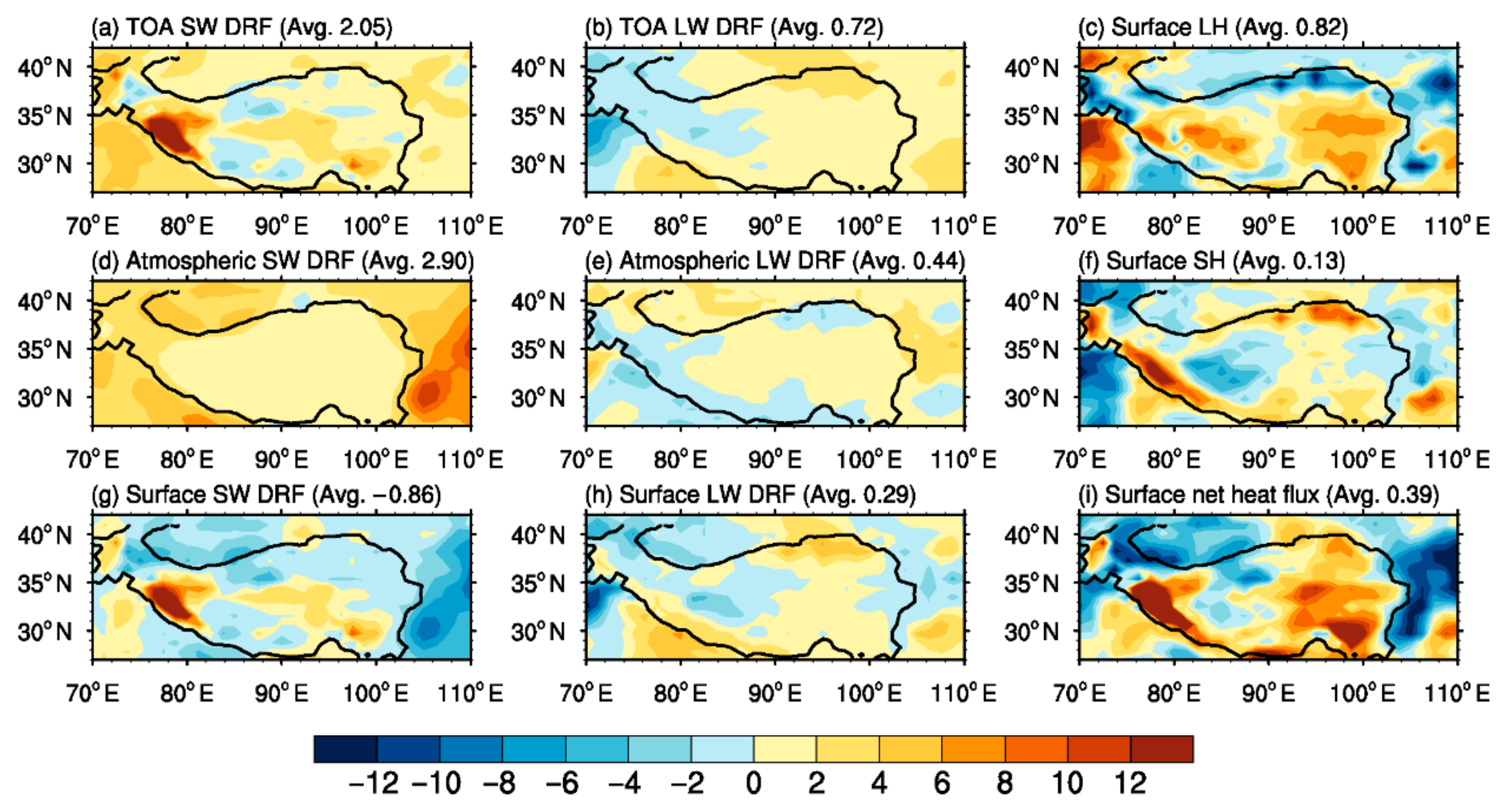
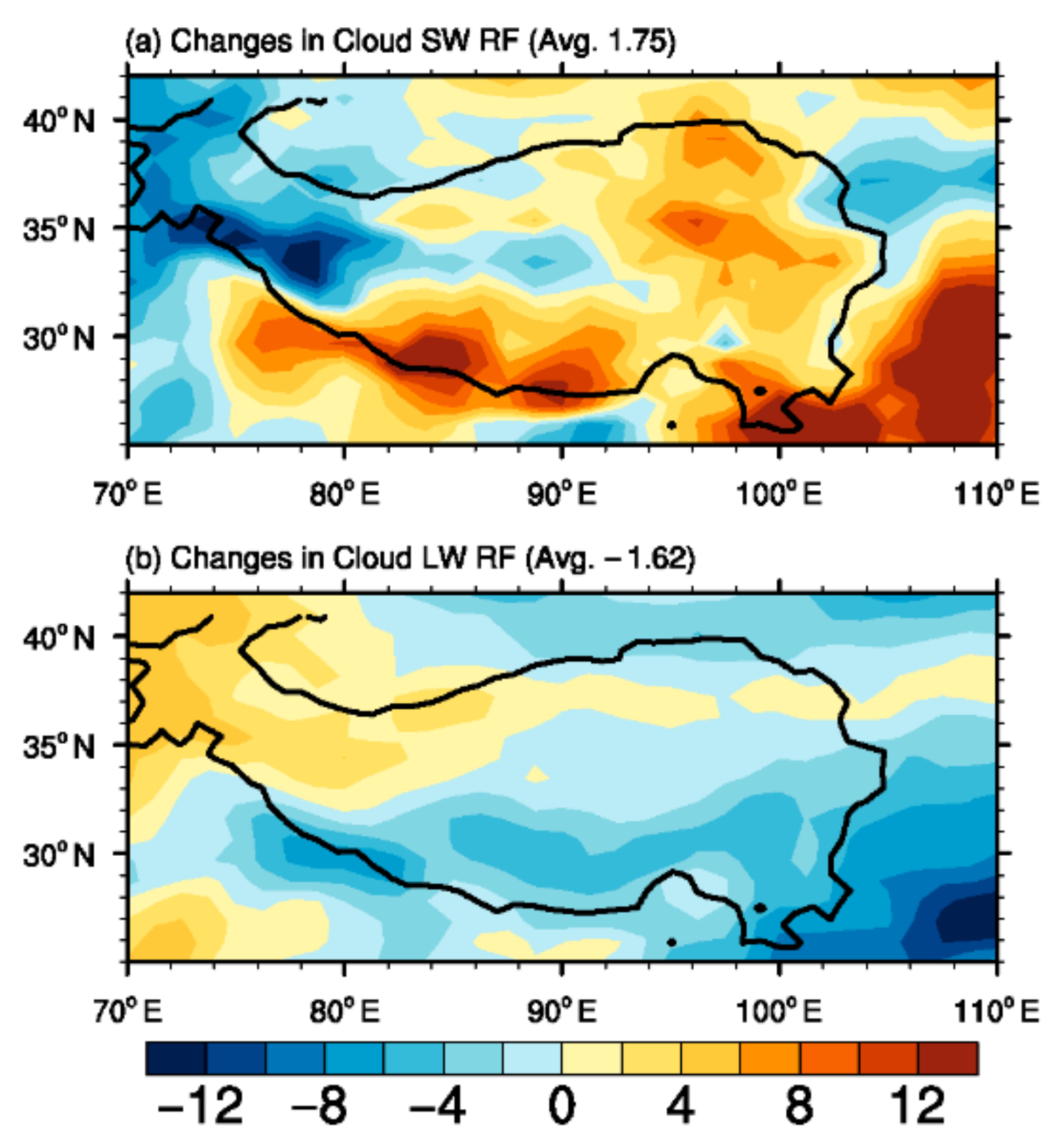
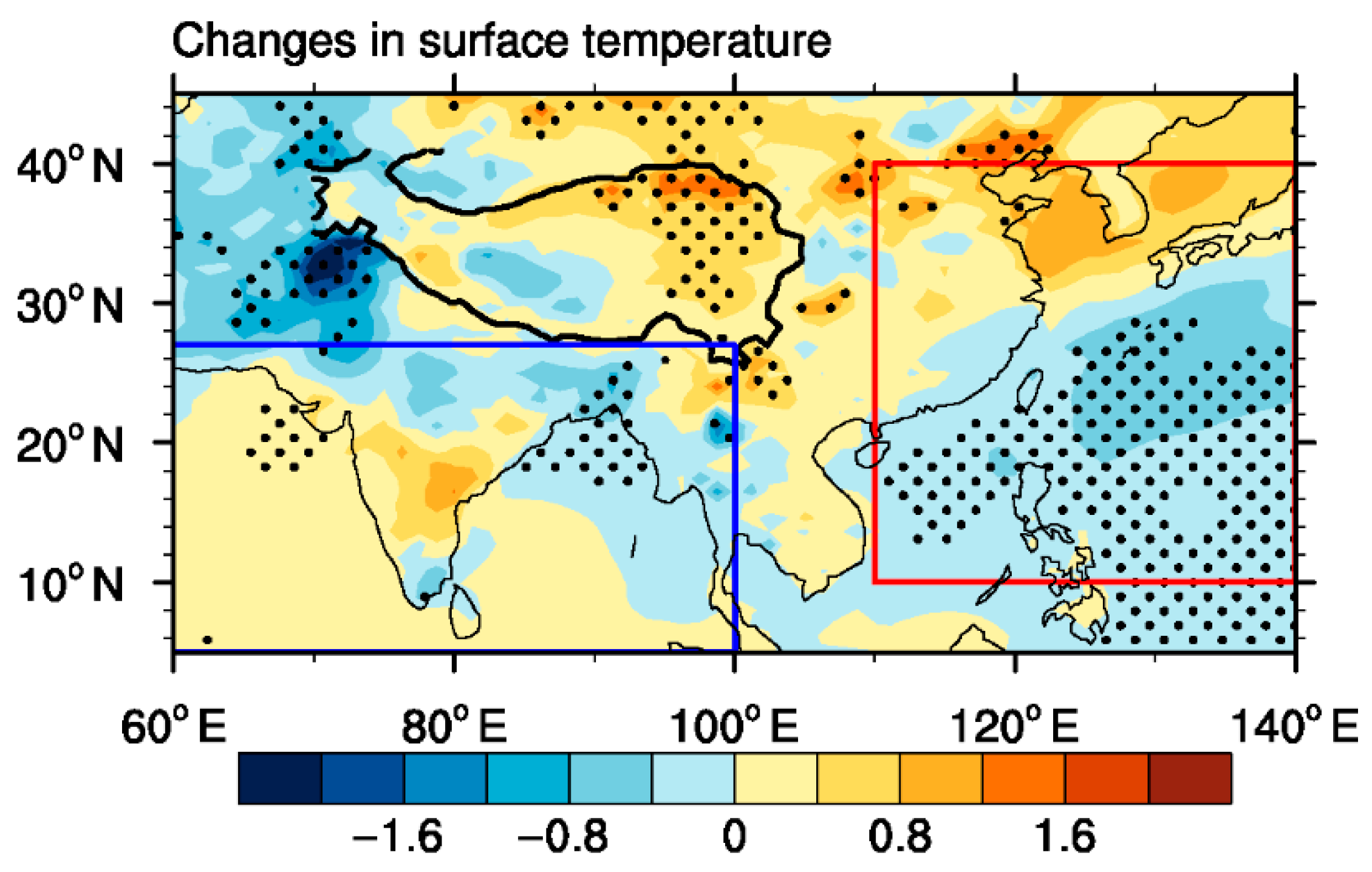
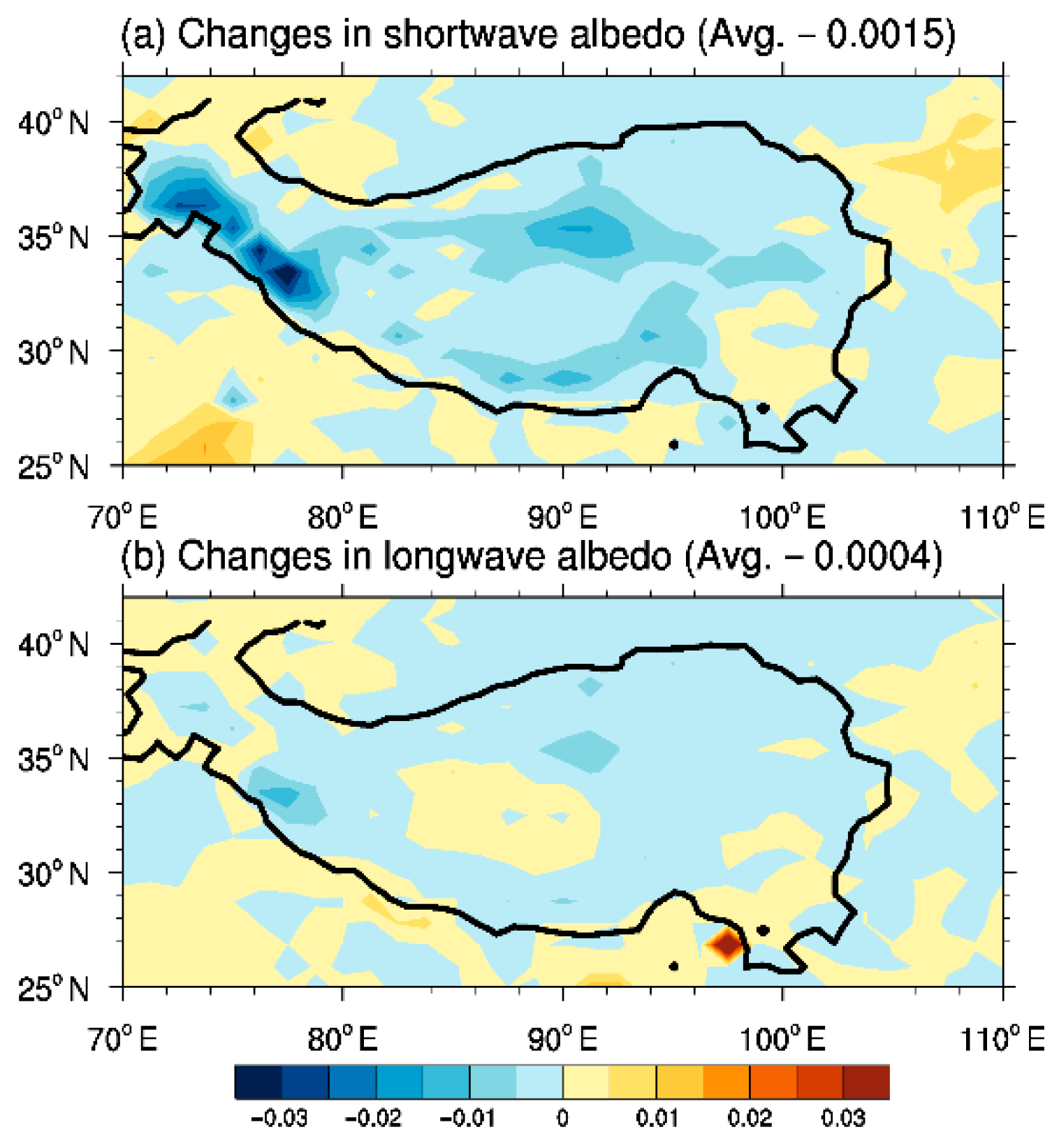
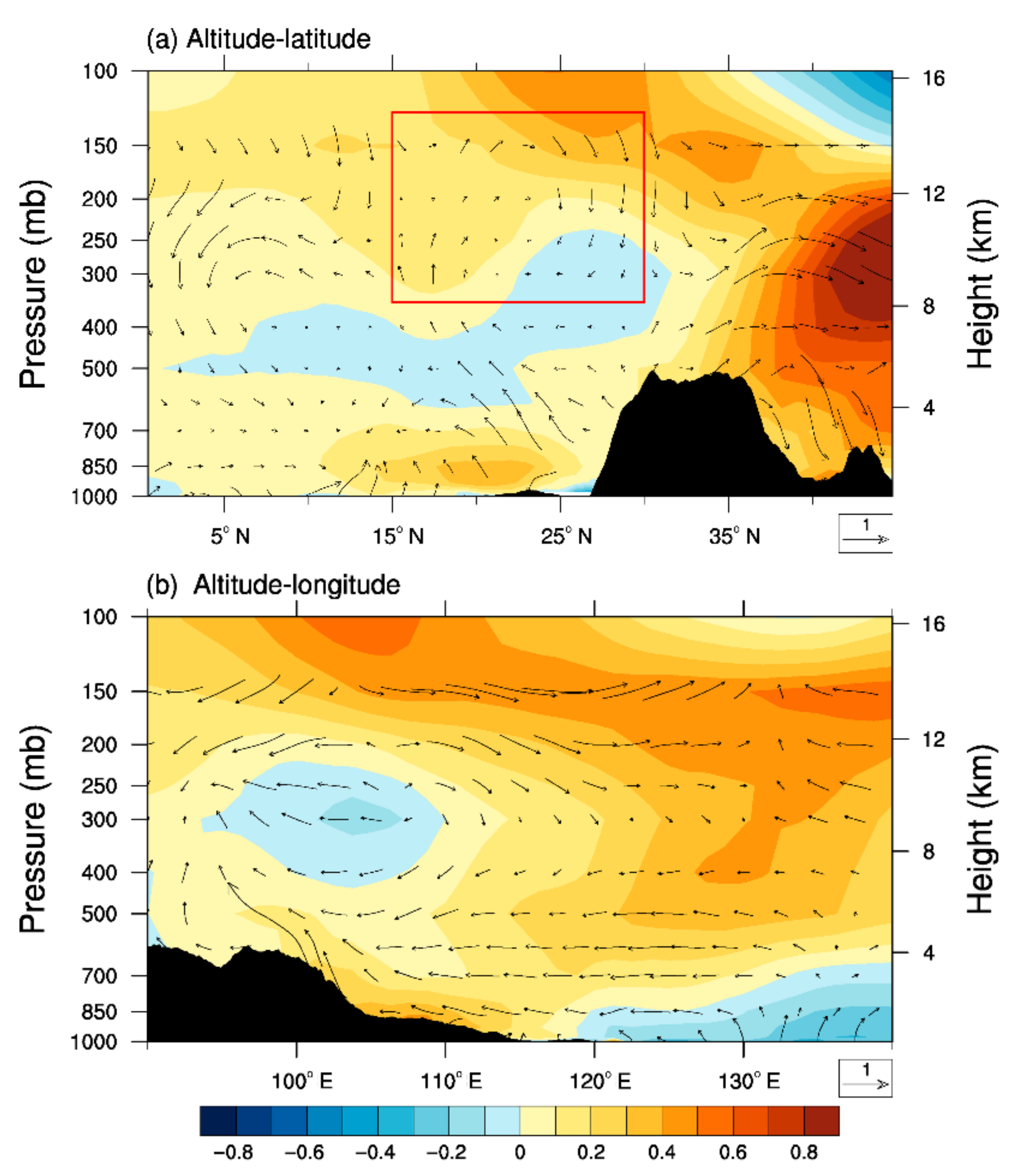
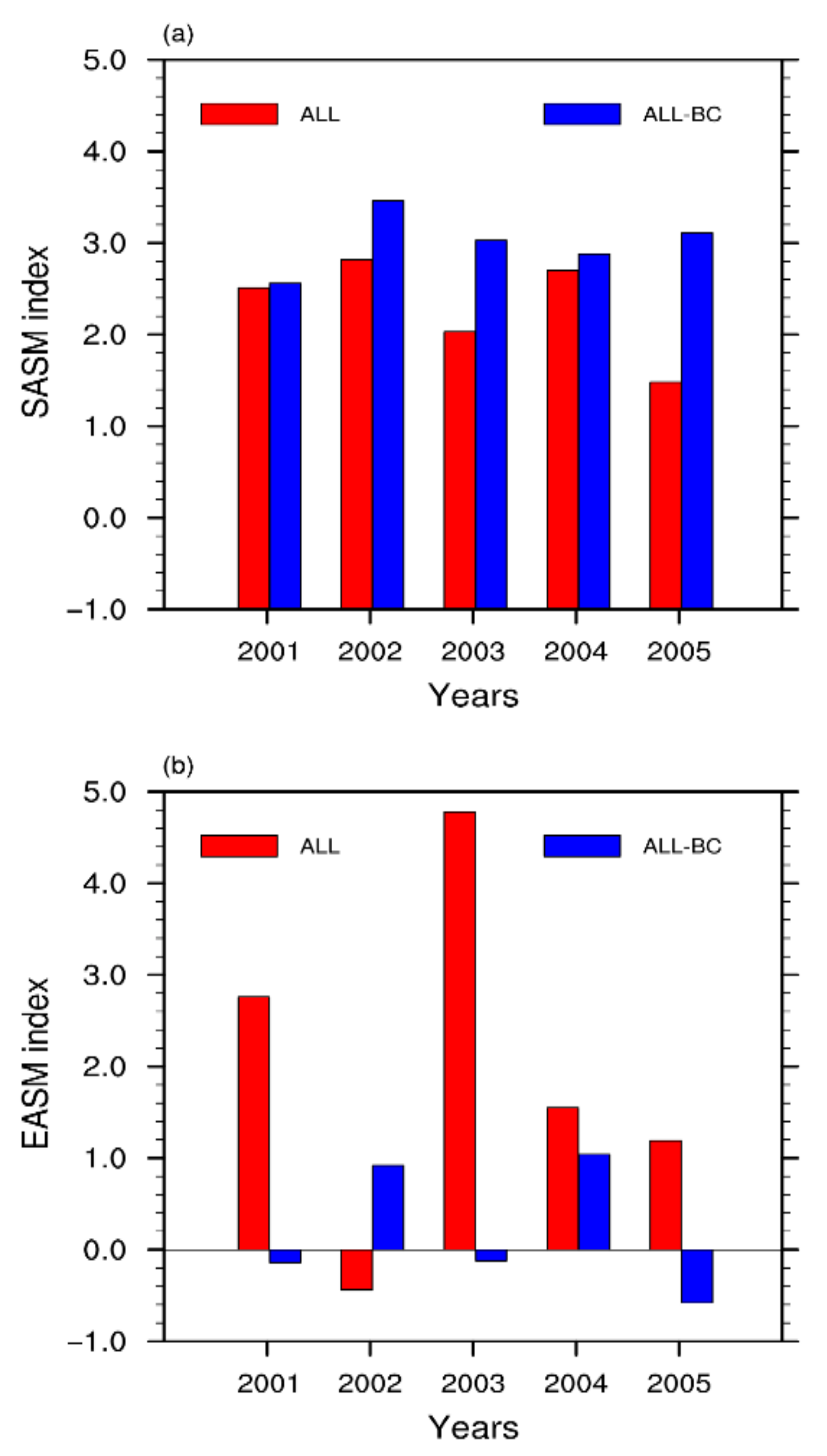
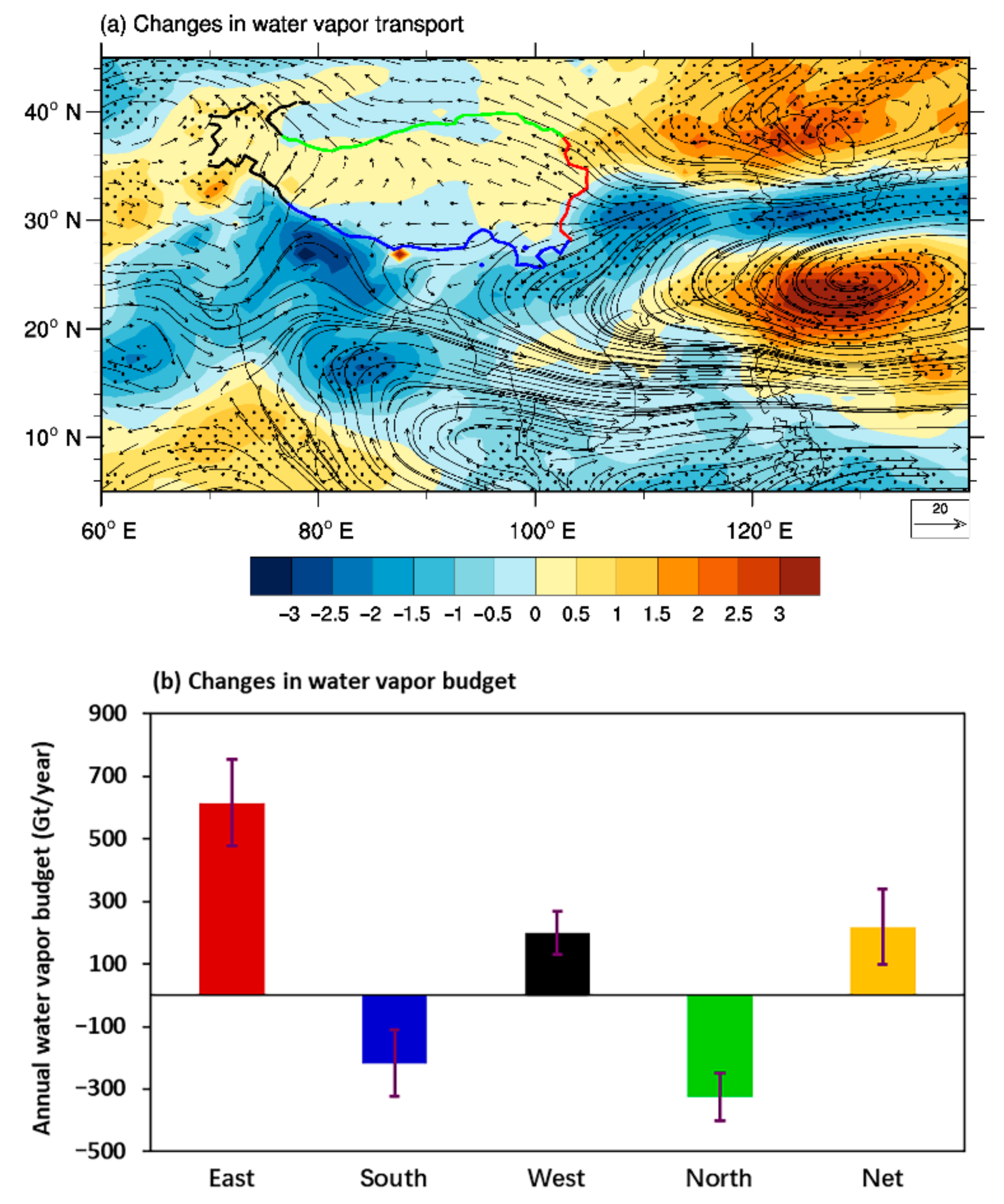

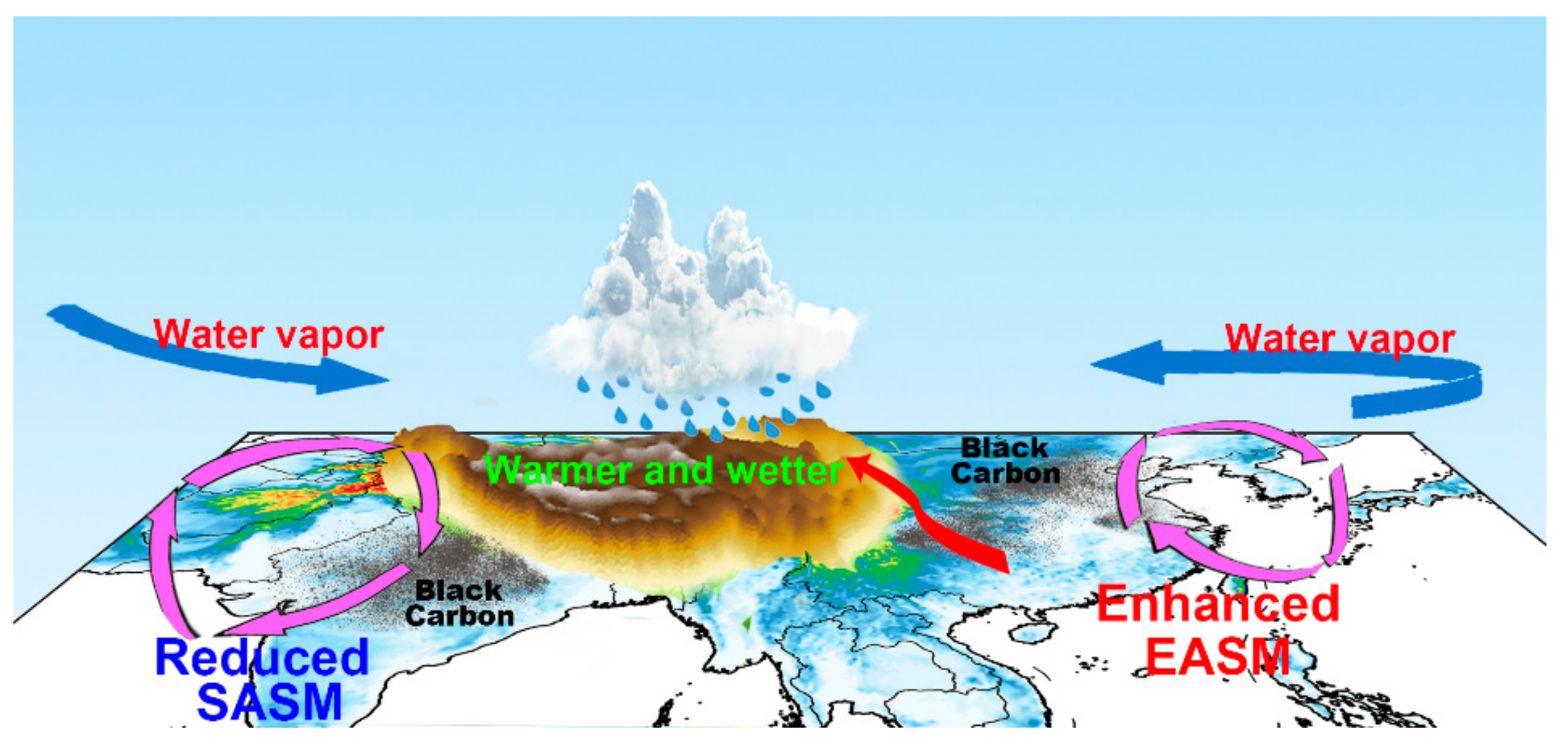
| Model Settings | Configurations |
|---|---|
| Horizontal resolutions | 0.9° × 1.25° |
| Vertical resolutions | 30 layers from the surface to 3.64 hPa |
| Physical schemes | Used schemes |
| Radiation schemes (Longwave, Shortwave) | Rapid radiative transfer model RRTMG |
| Cloud Microphysics scheme | MG scheme |
| Cloud Macrophysics scheme | Park scheme |
| Chemical schemes | Used schemes |
| Aerosol scheme | A 3-mode modal aerosol scheme MAM3 |
| Aerosol data sets | IPCC AR5 emissions of 2000 |
| Dry deposition | A resistance-based parameterization |
| Wet deposition | The wet removal routine |
© 2020 by the authors. Licensee MDPI, Basel, Switzerland. This article is an open access article distributed under the terms and conditions of the Creative Commons Attribution (CC BY) license (http://creativecommons.org/licenses/by/4.0/).
Share and Cite
Luo, M.; Liu, Y.; Zhu, Q.; Tang, Y.; Alam, K. Role and Mechanisms of Black Carbon Affecting Water Vapor Transport to Tibet. Remote Sens. 2020, 12, 231. https://doi.org/10.3390/rs12020231
Luo M, Liu Y, Zhu Q, Tang Y, Alam K. Role and Mechanisms of Black Carbon Affecting Water Vapor Transport to Tibet. Remote Sensing. 2020; 12(2):231. https://doi.org/10.3390/rs12020231
Chicago/Turabian StyleLuo, Min, Yuzhi Liu, Qingzhe Zhu, Yuhan Tang, and Khan Alam. 2020. "Role and Mechanisms of Black Carbon Affecting Water Vapor Transport to Tibet" Remote Sensing 12, no. 2: 231. https://doi.org/10.3390/rs12020231
APA StyleLuo, M., Liu, Y., Zhu, Q., Tang, Y., & Alam, K. (2020). Role and Mechanisms of Black Carbon Affecting Water Vapor Transport to Tibet. Remote Sensing, 12(2), 231. https://doi.org/10.3390/rs12020231




